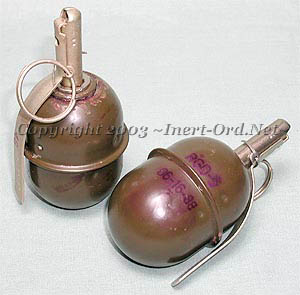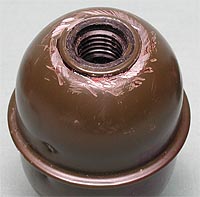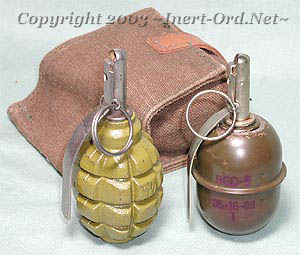 Ruchnaya Granata Degtyareva
Ruchnaya Granata Degtyareva
("Hand Grenade of the Degtyareva design")
This is Soviet RGD-5 developed after WWII.
Anyone know about what year? Post Korea
These particular ones were made in East Germany, (Indicated by the markings in Latin letters. Manufacturer code is factory "06" which is "Sprengstoffwerk Kapen"), but this type was also produced in other Warsaw Pact countries.
The RGD-5 consists of a two-piece sheet-steel body joined by a circumferential crimp with a hermetically sealed fuze well. An internal fragmentation liner produces about 350 fragments. It is filled with 110g of TNT
This was developed for maximum throwing range. A Russian grenade manual states an average throwing distance of 40-50 meters. Effective casualty radius is 15-20 meters and is hazardous out to about 30 meters. The RGD-5 reflects the modern design trend of maximum fragmentation effect within a limited blast radius. Today, molded plastic bodies and fragmentation matrixes have pretty much replaced cast and sheet metal designs.
The fuze is the E. German DS-62 (similar to the UZRGM type) with a curved safety lever. (Details)
Inerted RGD-5 grenades are not common to find as to the difficulties in deactivating them. The body is a sealed unit and must be cut open to remove the filler. Here you can see where the fuze well was removed and then re-attached.


At right is the F1 & RGD-5 in front of a typical Soviet grenade pouch, made of canvas. It has two pockets inside and is made to wear on the belt.
From Erik... He has sent in this photo of the RGO-78.
This is a modernized version of the RGD-5.
This one is from Bulgaria - designated by the code 22 (or 23) in circles.
Found with different fuzes, DRM or DVM-78, as well as the UZRGM.
Which fuze is this
Note the six short longitudinal ribs on each half. This is to hold an internal plastic fragmentaion matrix with about 850 steel balls.
The body is still made of two sheet metal hemisphers joined by a roll crimp.

This is a modernized version of the RGD-5.
This one is from Bulgaria - designated by the code 22 (or 23) in circles.
Found with different fuzes, DRM or DVM-78, as well as the UZRGM.
Which fuze is this
Note the six short longitudinal ribs on each half. This is to hold an internal plastic fragmentaion matrix with about 850 steel balls.
The body is still made of two sheet metal hemisphers joined by a roll crimp.